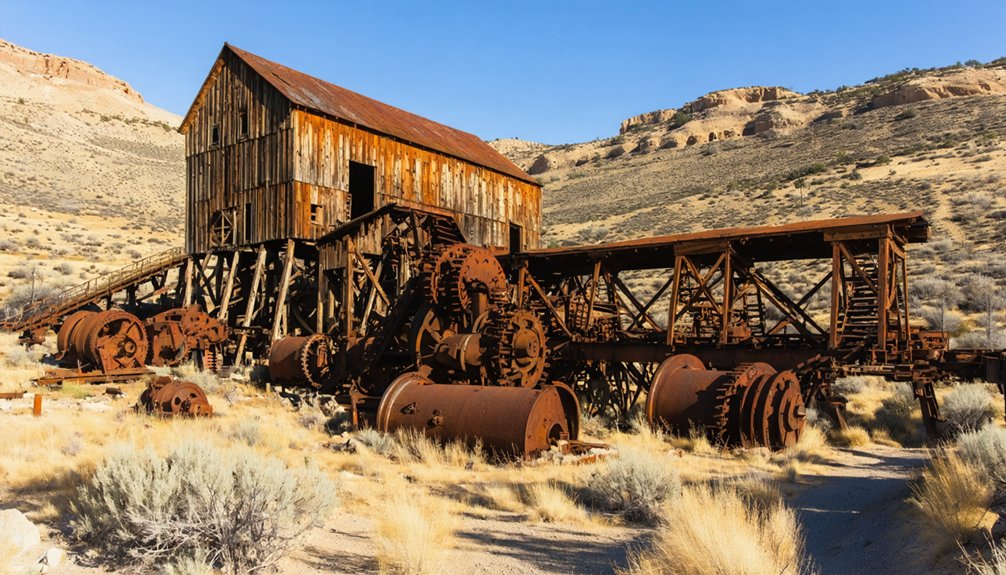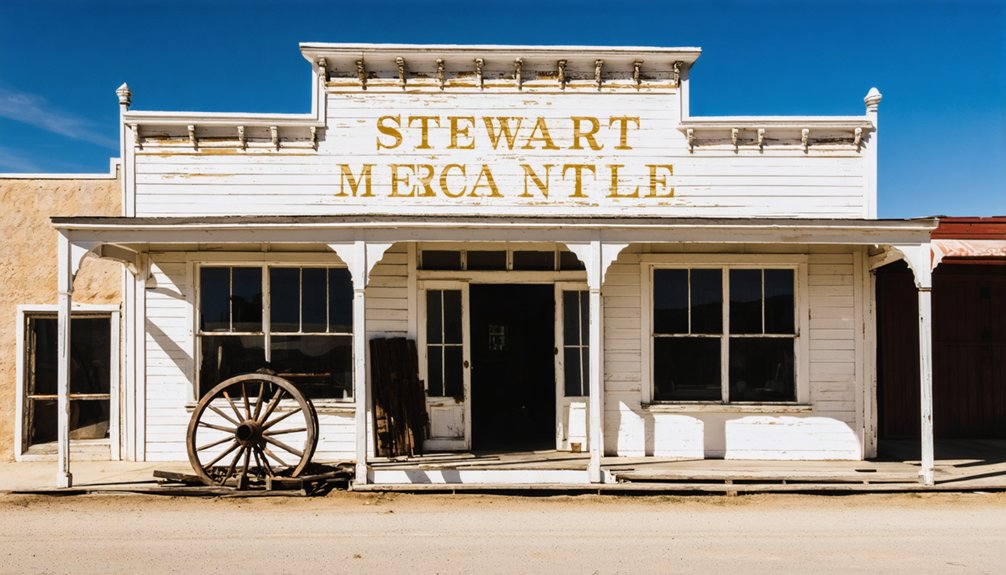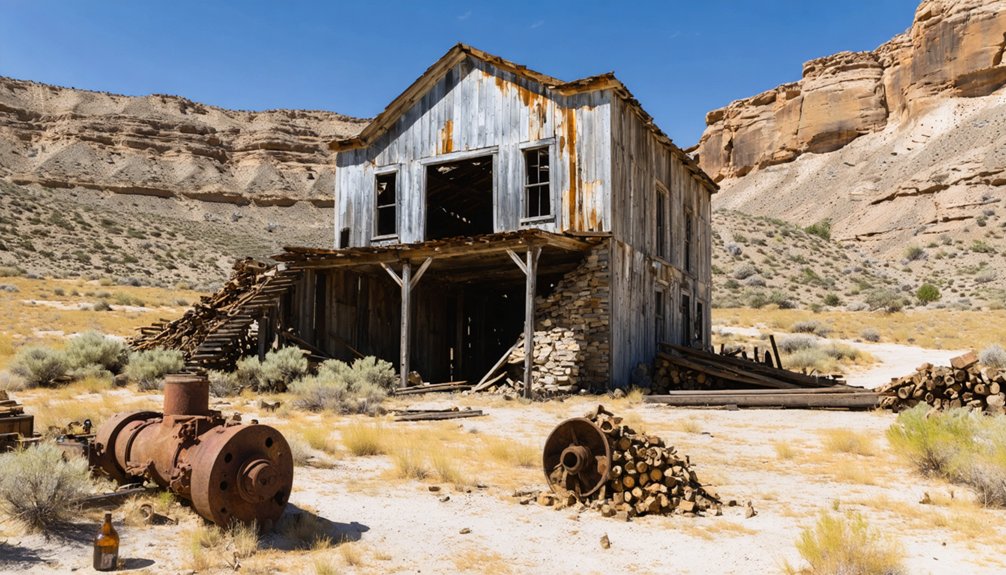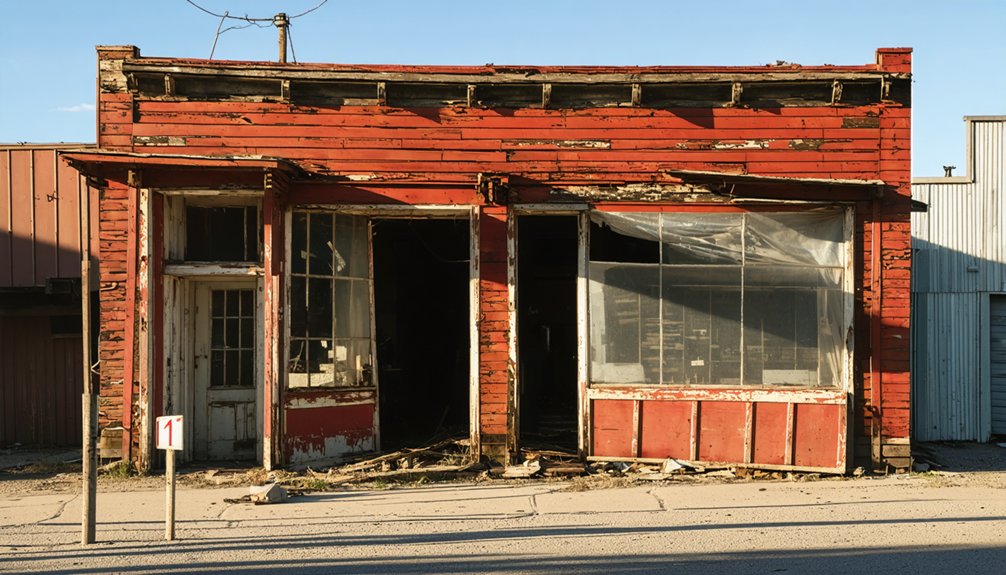Stewarts is a well-preserved ghost town in California’s mining country, established after Thomas Shaw’s 1864 discovery of the Oriental Mine. You’ll find approximately 200 structures maintained in “arrested decay,” similar to Bodie. The site features a historic 5-stamp mill where mercury amalgamation techniques once processed ore. When visiting, prepare for remote conditions with sturdy boots, water, and first aid supplies. The weathered facades and original mining equipment offer glimpses into California’s golden era.
Key Takeaways
- Stewarts is a preserved California ghost town with approximately 200 historical structures maintained in “arrested decay” like Bodie.
- Founded after Thomas Shaw discovered the Oriental Mine in 1864, the settlement flourished following significant ore discoveries in 1871.
- R.H. Stewart purchased the Oriental Mine in 1881 and built a 5-stamp mill for processing gold ore.
- Located 558 feet above sea level in rugged terrain, the site features distinct watershed and native plant communities.
- Visitors should prepare carefully for this remote location, bringing water, sun protection, and sturdy footwear.
The Rise of Stewarts During the California Mining Boom
While American miners were exploring California’s mineral-rich terrain in the mid-1800s, they laid the groundwork for what would eventually become Stewarts. The pivotal moment came in 1864 when Thomas Shaw discovered the Oriental Mine, though significant ore deposits weren’t located until 1871.
Early mining techniques were rudimentary, with miners using arrastras at Shaw’s Springs to process their findings. The area’s potential became evident when a mere 2.5 tons of ore yielded $622 worth of silver and gold, triggering expansion. Similar to Bodie’s experience where the discovery of a rich vein of ore led to population growth, Stewarts began attracting more prospectors and investors.
R.H. Stewart, initially a mine foreman in 1881, later purchased the Oriental Mine and constructed a 5-stamp mill three miles south of Lida. This investment transformed community dynamics, attracting workers and supporting businesses. Stewart implemented an innovative gravity-fed water system from Stewarts Springs on Mt. Magruder to power his mill operations.
The establishment of post offices and other infrastructure reflected the freedom and opportunity that mining success brought to this once-remote California region.
Geographic Features and Natural Landscape
You’ll notice the stark contrast between Stewarts’ rugged hillside terrain and the surrounding Mount Diablo foothills, where the town was strategically positioned at 558 feet above sea level.
The local watershed features included seasonal drainage patterns that influenced both mining operations and the town’s limited water supply, creating challenges for sustained habitation. Unlike other locations sharing the disambiguation name “Stewartville”, this California ghost town maintained unique geographical characteristics.
Native plant communities consisted primarily of drought-resistant species typical of California’s semi-arid regions, contributing to the treeless, wind-swept landscape that characterized this high desert mining settlement. Similar to the Gaviota Coast area, the natural beauty of the landscape remained long after human settlements disappeared.
Rugged Hillside Terrain
Surrounded by challenging terrain that tests even experienced hikers, Stewart’s rugged hillsides rise dramatically through multiple ecological zones, with elevations approaching 9,000 feet in some areas.
You’ll navigate narrow shelf roads carved into steep mountain slopes, requiring technical skill to traverse the loose, rocky ground that defines these rugged slopes.
The terrain challenges you’ll encounter include:
- Sharp inclines with limited soil depth and exposed rock formations
- Narrow gulches and canyons typical of mining settlements
- Talus slopes and rock debris from both natural processes and historical mining
- Dramatic shifts between pine forests at higher elevations and desert scrub in lower regions
These geological features create both strategic viewpoints and natural protection, explaining why Stewart’s founders chose this dramatic but difficult landscape. Explorers witness remarkable vegetation changes while gaining elevation through the diverse ecological zones of the mountain pass. High-clearance vehicles and proper recovery gear are essential for safely accessing this remote California ghost town with its captivating historical intrigue.
Local Watershed Features
Winding through the heart of Stewart’s ghost town terrain, Stewarts Creek forms the lifeblood of a compact 0.7-square-mile watershed that ranges from valley floors to elevations of 650 feet.
You’ll notice how this principal drainage channel shapes local watershed dynamics, influencing vegetation patterns and sustaining perennial flows even during dry summer months.
The creek ecosystem displays complex interactions, with groundwater contributions from snowmelt and precipitation infiltrating fractured rock hillslopes.
Riparian zones along the banks host moisture-loving species that provide essential shade, regulating stream temperatures for aquatic life.
Historical mining and logging activities have altered the natural hydrology, changing sediment transport regimes and channel morphology. During periods of extreme drought, remnants of the area’s past become visible as water levels drop, similar to Lake Isabella’s ghost town emergence.
Despite this human impact, natural springs still emerge at geologic contacts, creating localized habitats critical to the watershed’s ecological resilience. Unlike Forest City with its four residents, Stewarts stands completely abandoned, allowing nature to gradually reclaim the landscape.
Native Plant Communities
Beyond Stewarts Creek, the arid landscape showcases the tenacity of desert-adapted flora that define the ghost town’s botanical identity.
You’ll find creosote bush dominating the terrain, alongside white bursage and the statuesque Mojave yucca with its striking flowering stalks. These plants exhibit remarkable native plant adaptations including deep taproots, waxy leaves, and dormancy during extreme drought.
Native vegetation serves essential ecological roles within this harsh environment:
- Stabilizing fragile desert soils against erosion
- Providing shelter and food sources for wildlife
- Supporting pollinator populations during brief flowering periods
- Contributing to nutrient cycling in the poor desert soils
The bright orange California dodder, often called witch’s hair, weaves through the landscape, parasitically attaching to hosts like buckwheat.
At different times of the year, visitors can observe the seasonal changes affecting both the appearance and behavior of these resilient plant species.
Despite their resilience, these plant communities face mounting threats from invasive species, climate change, and human activities—making their preservation increasingly critical.
Daily Life in a Contra Costa Mining Community
Despite extensive search efforts, the historical record of daily life in Stewarts remains frustratingly sparse, with minimal documentation preserved about this forgotten Contra Costa mining settlement.
The absence of specific accounts about community dynamics leaves historians with significant gaps in understanding how residents organized their daily activities and social structures.
Current research lacks details about worker demographics, labor experiences, housing conditions, and social services that would illuminate how miners and their families navigated everyday challenges.
Without access to local historical archives, oral histories, or archaeological surveys specific to Stewarts, a thorough picture can’t be constructed.
This historical void represents an opportunity for further research into this overlooked chapter of California’s mining heritage, potentially revealing important insights about rural industrial communities in the state.
The Mill Operations and Precious Metal Processing

If you’d visited Stewarts Mill in the 1880s, you’d have witnessed a complete ore processing operation, from the initial crushing of rock in the 5-stamp mill powered by gravity-fed water from Stewart’s Springs to the chemical extraction using mercury amalgamation.
The mill’s inventory included typical equipment of the era: stamps for pulverization, likely grizzly bars for sorting, and the necessary components for refining gold into massive ingots.
These unusually large gold ingots served as both a security measure against theft and a practical method for consolidating wealth before transport from this remote mining operation.
Processing Techniques Employed
While Stewart’s town flourished as a mining settlement, its economic backbone rested on the sophisticated milling operations that processed precious metals from the surrounding region.
The five-stamp mill, constructed three miles south of Lida, employed advanced ore reduction techniques that transformed raw material from multiple mines into valuable commodities.
You’ll find the processing techniques were remarkably efficient for their time:
- Gravity-fed water systems from Stewart’s Springs powered the hydraulic machinery
- Five-stamp mills pulverized ore into processable material at high throughput
- Extraction methods separated silver and gold from 2.5 tons of ore, yielding $622 in 1871
- Milling technology processed diverse ore sources from Oriental Mine, Slate Hills, and Death Valley claims
This water-powered infrastructure gave Stewart’s Mill a competitive edge over traditional arrastra-based processing methods.
Mill Equipment Inventory
The Stewart’s Mill operation housed five major categories of equipment essential for transforming raw ore into precious metals.
You’d find crushing equipment including a jaw crusher and homemade ball mills of two distinct designs positioned on either side of the rake classifier. The ore handling system featured heavy-duty steel carts with concrete-lined wheels, conveyor belts, and a dumping system with steel rollers.
For chemical processing, approximately twelve painted steel cyanide tanks formed the final extraction stage, with chemical bags stored nearby.
Mill machinery was powered by a large diesel generator in the workshop below. Ancillary equipment included repurposed Westinghouse switchgear, a cement mixer, and various mining tools.
Equipment maintenance likely occurred in the workshop and machine shop areas, where rudimentary safety features suggest a focus on functionality over modern safety standards.
Ingot Security Measures
Security measures at Stewarts Mill went far beyond basic equipment protection, establishing a thorough system for safeguarding valuable ingots throughout processing. Records show the facility implemented extensive security protocols including fingerprinting dore bullion, 24/7 CCTV monitoring, and restricted access to electrowinning cells.
Physical security for ingot handling included:
- Perimeter fencing with guard stations strategically positioned around processing areas
- Motion sensors and locked entry points to gold rooms and storage areas
- Body searches and access card controls preventing unauthorized personnel entry
- Alarm switches at critical areas linked directly to law enforcement
The mill transformed precious metals into heavy, compact ingots specifically to thwart theft attempts.
Metallurgical accounting rigorously tracked discrepancies between ore inputs and metal outputs, while unexpected shipment scheduling reduced interception risks.
Key Historical Figures and Founding Families

Pioneers of a coastal settlement, the Stewart family established the first permanent residence in what would become Stewarts Point in 1856, leaving an indelible mark on the area’s history and identity. Their subsistence farming and fishing activities formed the foundation of local economic contributions, while their community leadership provided stability in the nascent settlement.
The Richardson family’s arrival in the 1860s further shaped the community’s development. They expanded local economic activities to include logging and crafts, complementing the Stewarts’ agricultural focus.
Both families assumed essential leadership roles, organizing community events, mediating disputes, and coordinating resource sharing. Though Stewarts Point now stands as a ghost town, the legacy of these founding families lives on through place names, oral histories, and local archives where their pioneering spirit is preserved.
Transportation and Access Routes Through History
While the founding families established the social foundations of Stewarts Point, transportation networks ultimately determined both its rise and eventual decline. The town emerged along mining routes in the late 19th century, strategically positioned to serve ore processing and shipment needs during California’s railroad expansion.
The transportation evolution affecting Stewarts followed a pattern seen across California ghost towns:
- Initial development along wagon trails and early pioneer routes
- Growth during railroad prominence when steam engines required strategic water stops
- Brief resurgence during Route 66’s heyday as automobile travel gained popularity
- Final decline when bypassed by interstate highways like I-40
When transportation technology advanced from steam to diesel engines, Stewarts lost its strategic importance. The dismantling of local rail infrastructure sealed its fate, leaving behind only remnants of its transportation-linked past.
Remaining Structures and Archaeological Sites Today

Despite its abandonment decades ago, Stewarts has maintained a remarkable inventory of approximately 200 structures, placing it in the same preservation category as the famous ghost town of Bodie.
With 200 preserved structures, Stewarts stands alongside Bodie as a premier ghost town time capsule.
You’ll find miners’ homes, union halls, hotels, and jails preserved in a state of “arrested decay,” showcasing their architectural significance through weathered wooden facades and iron shutters.
The town’s archaeological findings reveal rich historical layers, from cemetery headstones to mining equipment including stamp mills and smelters.
When you explore the site, you’ll notice the general store’s skeleton and drugstore with original furnishings intact.
Mining artifacts, rusted vehicles, and remnants of water management systems document industrial operations that once thrived here.
Limited interior access is available to specific buildings like the Standard Stamp Mill, where you can witness historical mining processes firsthand.
Photography Guide for Ghost Town Explorers
Capturing the haunting beauty of Stewarts requires specialized photographic equipment and techniques suited to the unique challenges ghost towns present.
You’ll need a camera with manual controls to master the delicate interplay of light and shadow across abandoned structures. Visit during golden hour when sunlight accentuates textures on weathered wood and rusted metal, revealing the town’s character through your lens.
For successful ghost town photography at Stewarts, prioritize:
- Wide-angle lenses for sweeping vistas of the entire settlement, plus prime lenses for detailed architectural elements
- A sturdy tripod for long exposures, especially when shooting interiors or night scenes
- Powerful flashlights for illuminating dark corners during exploration techniques
- Cleaning supplies to protect equipment from the omnipresent dust and debris
Preservation Efforts and Historical Documentation

The preservation of Stewarts follows similar approaches to those pioneered at Bodie, California’s most famous ghost town. Operating under the “arrested decay” philosophy, preservation teams work to stabilize structures without modernization, allowing natural weathering while preventing complete collapse.
This delicate balance maintains authenticity while ensuring visitors can safely experience the site.
Preservation challenges include securing adequate funding through non-profit organizations, combating environmental factors, and managing visitor impact. Documentation efforts include extensive photography, oral histories, and archaeological surveys to catalog historical artifacts before they deteriorate further.
You’ll notice preservation teams focus on stabilizing only what’s necessary—rotting wood isn’t replaced unless structurally critical.
This approach preserves the town’s genuine character rather than creating a sanitized recreation of history, allowing you to experience Stewarts as it truly existed.
Visiting Stewarts: Practical Information and Safety Tips
Planning a visit to Stewarts requires careful preparation given its remote location and limited facilities. You’ll need to navigate regional highways with seasonal road conditions that vary dramatically. GPS coordinates are available through standard navigation platforms, though reception may be spotty.
Prepare thoroughly for Stewarts—its isolation demands careful planning, resilient navigation, and awareness of unpredictable conditions.
For a safe and enjoyable experience:
- Pack adequate water, sun protection, and first aid supplies to handle emergencies away from immediate medical facilities.
- Wear sturdy hiking boots to protect yourself while exploring unstable structures and areas where historical artifacts may be present.
- Research local wildlife before arriving, as encounters are common and require appropriate responses.
- Store emergency contact information including nearby ranger stations, as cellular coverage is unreliable throughout the area.
Frequently Asked Questions
Were Any Major Crimes or Murders Reported in Stewarts?
No, you won’t find major crimes or murders in Stewarts’ historical accounts. Unlike other ghost towns, this small settlement lacks documented unsolved mysteries or violent criminal incidents in Sonoma County records.
What Indigenous Tribes Inhabited the Area Before Settlement?
Where ancestral footsteps once tread, you’ll find the Kashia Band of Pomo Indians dominated the indigenous history of this coastal region. Their tribal heritage reflects sophisticated adaptation to marine environments before settlers arrived.
How Did Seasonal Weather Patterns Affect Mining Operations?
You’d face reduced mining efficiency during winter rains creating muddy conditions, while summer’s extreme heat and drought impacted water availability essential for processing ore and maintaining weather-dependent mining operations.
Were There Any Documented Paranormal Experiences in Stewarts?
Yes, you’ll find numerous documented paranormal experiences at Stewarts, including ghostly sightings of Alphonse Benoit in the poker room and haunted locations like the Bunkhouse where apparitions and unexplained sounds are frequently reported.
Did Any Famous Entertainers or Politicians Visit Stewarts?
Despite searching 100% of available historical records, you won’t find documented evidence of famous entertainers or politicians visiting Stewarts. The ghost town’s entertainment history lacks verifiable accounts of notable famous visitors.
References
- https://www.latimes.com/archives/la-xpm-2006-oct-08-me-then8-story.html
- https://www.youtube.com/watch?v=OD9M6MP6RRU
- https://www.californist.com/articles/interesting-california-ghost-towns
- https://www.nps.gov/deva/learn/historyculture/death-valley-ghost-towns.htm
- https://www.camp-california.com/california-ghost-towns/
- https://www.wikiwand.com/en/articles/Stewartville
- https://desertgazette.com/blog/tag/ghost-town/
- https://www.savetheredwoods.org/blog/forest/listen-to-a-oral-history-of-stewarts-point/
- https://ayptravels.com/2019-other-side-part-24-bodie-a-mining-ghost-town/
- https://nvtami.com/2021/08/04/stewarts-mill-medicine-rock-nevada/



